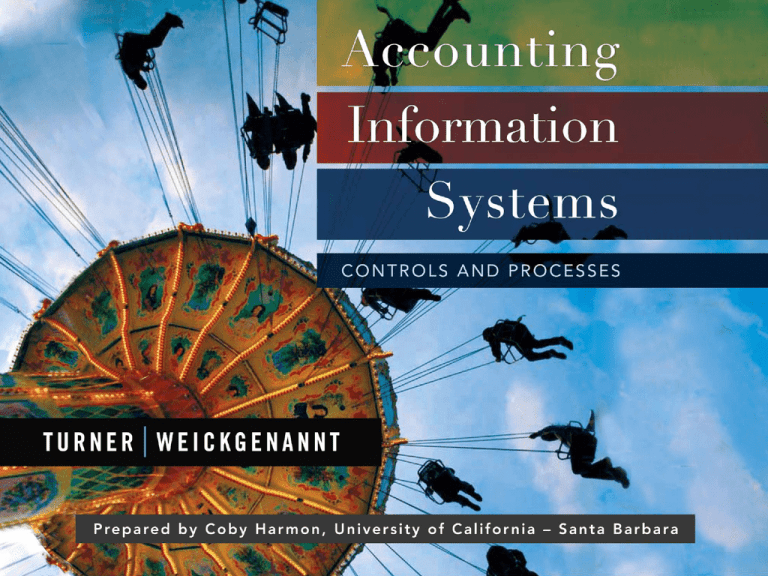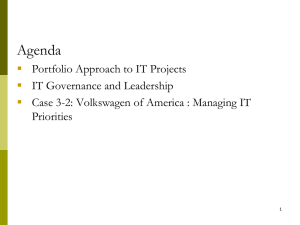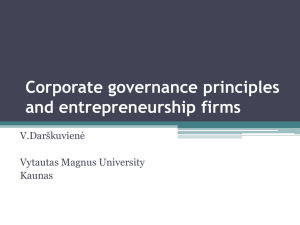
Chapter
5-1
Chapter
5-2
Corporate
Governance and
the SarbanesOxley Act
Accounting Information Systems, 1st Edition
Study Objectives
1.
An overview of corporate governance
2.
Participants in the corporate governance process
3.
The functions within the corporate governance process
4.
The history of corporate governance
5.
The Sarbanes–Oxley Act of 2002
6.
The impact of the Sarbanes–Oxley Act on corporate
governance
7.
The importance of corporate governance in the study of
accounting information systems
8.
Ethics and corporate governance
Chapter
5-3
An Overview of Corporate Governance
Accountants would characterize corporate
governance as a system of checks and balances
whereby a company’s leadership is held accountable
for building:
shareholder value and
creating confidence in the financial reporting
processes.
Tone at the top - set of values and behaviors in place for
the corporate leaders.
Chapter
5-4
SO 1 An overview of corporate governance
An Overview of Corporate Governance
Concept Check
Which of the following is not considered a component
of corporate governance?
a. Board of directors oversight.
b. IRS audits.
c. Internal audits.
d. External audits.
Chapter
5-5
SO 1 An overview of corporate governance
An Overview of Corporate Governance
Concept Check
Good corporate governance is achieved when the
interests of which of the following groups are
balanced?
a. Internal auditors and external auditors.
b. Shareholders and regulators.
c. Shareholders, the corporation, and the
community.
d. Regulators and the community.
Chapter
5-6
SO 1 An overview of corporate governance
An Overview of Corporate Governance
Concept Check
Corporate governance is primarily concerned with
a. enhancing the trend toward more women serving
on boards of directors..
b. promoting an increase in hostile takeovers.
c. promoting the legitimacy of corporate charters.
d. emphasizing the relative roles, rights, and
accountability of a company’s stakeholders.
Chapter
5-7
SO 1 An overview of corporate governance
Participants in Corporate Governance Process
Exhibit 5-1
Stakeholders as participants
in the corporate governance
process
Stakeholders are all
of the different
people who have some
form of involvement or
interest in the
business.
Chapter
5-8
SO 2 Participants in
the corporate
governance process
SO 1 An overview of corporate governance
Participants in Corporate Governance Process
Exhibit 5-1
Stakeholders as participants
in the corporate governance
process
Internal Stakeholders
Shareholders
Board of directors
Audit committee
Management
Employees
Internal auditors
Chapter
5-9
Participants in Corporate Governance Process
Exhibit 5-1
Stakeholders as participants
in the corporate governance
process
External Stakeholders
External auditors
Governing bodies
Communities
Investors
Creditors
Customers and
suppliers
Chapter
5-10
Participants in Corporate Governance Process
Concept Check
The governing body responsible for establishing the
COSO framework for internal controls evaluations is
the
a. Treadway Commission.
b. SEC.
c. PCAOB.
d. FASB.
Chapter
5-11
Functions Within Corporate Governance Process
Management Oversight
Policies and procedures in place to lead the directorship
of the company.
Features of effective leaders:
recruiting,
motivating,
evaluating,
problem solving, and
decision making.
Chapter
5-12
SO 3 The functions within the corporate governance process
Functions Within Corporate Governance Process
Internal Controls and Compliance
Accurate and transparent financial reporting requires a
process approach. Six-step process for internal controls:
Define key activities and resources.
Define objectives of each activity.
Obtain input from experienced users and advisors on the
effective design of controls.
Formally document the details of controls.
Test the effectiveness of controls.
Engage in continuous improvement.
Chapter
5-13
SO 3 The functions within the corporate governance process
Functions Within Corporate Governance Process
Financial Stewardship
Discipline, respect, and accountability encourage good
financial stewardship.
Earnings management - manipulating financial information.
early recognition of revenues
early shipment of products
falsification of customers
falsification of invoices or other records
allowing customers to take products without taking title to
the products
Chapter
5-14
SO 3 The functions within the corporate governance process
Functions Within Corporate Governance Process
Ethical Conduct
Integrity, fairness, and accountability are the underlying
concepts in each of the roles of corporate governance.
Chapter
5-15
SO 3 The functions within the corporate governance process
Functions Within Corporate Governance Process
Concept Check
When financial information is presented properly and
its correctness is verifiable, it is
a. transparent.
b. compliant.
c. accurate.
d. accountable.
Chapter
5-16
SO 3 The functions within the corporate governance process
History of Corporate Governance
Corporate governance first came to light in the 1930s
with the creation of the Securities and Exchange
Commission and in reaction to the accounting problems
connected with the market crash of 1929 and the Great
Depression.
Over the years, the concept has evolved as the business
world has shifted focus from materiality to earnings
pressures and, most recently, to the requirements of the
Sarbanes–Oxley Act.
Chapter
5-17
SO 4 The history of corporate governance
Sarbanes–Oxley Act of 2002
The Sarbanes–Oxley Act (“the Act”) applies to public
companies and the auditors of public companies.
The Public Company Accounting Oversight Board
(PCAOB) was established.
PCAOB comprises five members appointed by the SEC.
PCAOB governs the work of auditors of public
companies
PCAOB has investigative and disciplinary authority
over the performance of public accounting firms.
Chapter
5-18
SO 5 The Sarbanes-Oxley Act of 2002
Sarbanes–Oxley Act of 2002
Certain sections of the Act pertain to audit services.
201—Services outside scope of practice of auditors.
301—Public company audit committees.
302—Corporate responsibility for financial reports.
906—Failure of corporate officers to certify financial
reports.
401—Disclosures in periodic reports.
404—Management assessment of internal controls.
406—Code of ethics for senior financial officers.
Chapter
5-19
SO 5 The Sarbanes-Oxley Act of 2002
Sarbanes–Oxley Act of 2002
Certain sections of the Act pertain to audit services.
409—Real-time disclosures.
802—Criminal penalties for altering documents.
1102—Tampering with a record or otherwise impeding
an official proceeding.
806—Protection for employees of publicly traded
companies who provide evidence of fraud.
Chapter
5-20
SO 5 The Sarbanes-Oxley Act of 2002
Sarbanes–Oxley Act of 2002
Concept Check
Which of the following nonaudit services may be
performed by auditors for a public-company audit client?
a. IT consulting regarding the general ledger system for
a newly acquired division.
b. Programming assistance on the new division’s general
ledger system.
c. Human resources consulting regarding personnel for
the new division.
d. Income tax return preparation for the new division.
Chapter
5-21
SO 5 The Sarbanes-Oxley Act of 2002
Sarbanes–Oxley Act of 2002
Concept Check
Section 806 of the Sarbanes–Oxley Act is often referred to
as the whistleblower protection provision of the Act because
a. It offers stock ownership to those who report
instances of wrongdoing.
b. It specifies that whistleblowers must be terminated
so as to avoid retaliation.
c. It protects whistleblowers’ jobs and prohibits
retaliation.
d. It provides criminal penalties for the alteration or
destruction of documents.
Chapter
5-22
SO 5 The Sarbanes-Oxley Act of 2002
Impact of Sarbanes–Oxley Act
Management Oversight
More knowledgeable about accounting principles and
financial systems.
Management certification of financial information.
Rigid penalties for noncompliance.
Chapter
5-23
SO 6 The impact of the Sarbanes–Oxley Act on corporate governance
Impact of Sarbanes–Oxley Act
Internal Controls and Compliance
Extra work for accountants, IT departments, and
executives.
More paperwork is now prepared, retained, and filed
with the SEC.
More timely information is required.
Section 404 requires companies to monitor their
systems to find weaknesses in internal controls.
Chapter
5-24
SO 6 The impact of the Sarbanes–Oxley Act on corporate governance
Impact of Sarbanes–Oxley Act
Financial Stewardship
Act has caused many companies to take a deeper look at
their policies and procedures that govern corporate
conduct.
Ethical Conduct
codes of conduct
performance evaluation models
communications
Chapter
5-25
SO 6 The impact of the Sarbanes–Oxley Act on corporate governance
Impact of Sarbanes–Oxley Act
Concept Check
In the corporate governance chain of command, the
audit committee is accountable to
a. The company’s vendors and other creditors.
b. Management and employees.
c. Governing bodies such as the SEC and PCAOB.
d. The external auditors.
Chapter
5-26
SO 6 The impact of the Sarbanes–Oxley Act on corporate governance
Impact of Sarbanes–Oxley Act
Concept Check
Which of the following is true regarding the postSarbanes–Oxley role of the corporate leader?
a.
More emphasis is placed on strategic planning and less
emphasis on financial information.
b. The corporate leader must be more in tune with IT to
provide corporate governance solutions.
c.
The corporate leader must be more focused on merger
and acquisition targets.
d. The corporate leader tends to be less involved with the
board of directors.
Chapter
5-27
SO 6 The impact of the Sarbanes–Oxley Act on corporate governance
Corporate Governance in the Study of AIS
The Sarbanes–Oxley Act heightens the business value of
financial information. Since the Act requires more
financial information and faster financial reporting, there
is more attention than ever on the importance of the
accountants and IT personnel who provide financial
information for the company.
Chapter
5-28
SO 7 Importance of corporate governance in the study of AIS
Ethics and Corporate Governance
Internal stakeholders may sometimes have difficult
ethical choices to make when their personal interests
conflict with the interests of shareholders.
Corporate governance must provide the structure to
make sure that a system of financial stewardship is
maintained, even when times get tough.
Chapter
5-29
SO 8 Ethics and corporate governance
Ethics and Corporate Governance
Concept Check
Many corporate frauds involve
a. Managers soliciting assistance from their
subordinates.
b. A small deceptive act that intensifies into
criminal behavior
c. An earnings management motive.
d. All of the above.
Chapter
5-30
SO 8 Ethics and corporate governance
Copyright
Copyright © 2008 John Wiley & Sons, Inc. All rights reserved.
Reproduction or translation of this work beyond that permitted
in Section 117 of the 1976 United States Copyright Act without
the express written permission of the copyright owner is
unlawful. Request for further information should be addressed
to the Permissions Department, John Wiley & Sons, Inc. The
purchaser may make back-up copies for his/her own use only
and not for distribution or resale. The Publisher assumes no
responsibility for errors, omissions, or damages, caused by the
use of these programs or from the use of the information
contained herein.
Chapter
5-31








